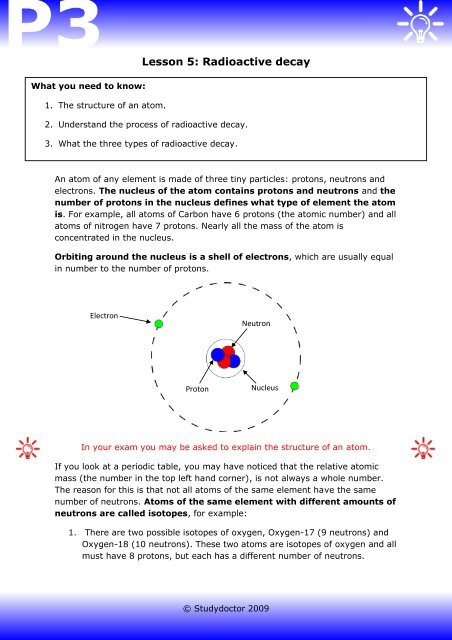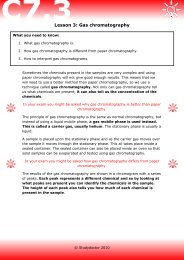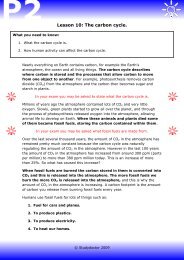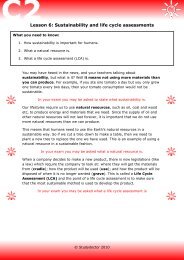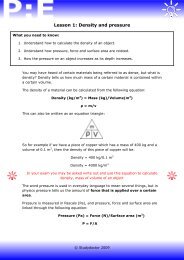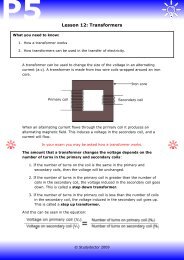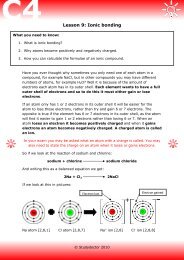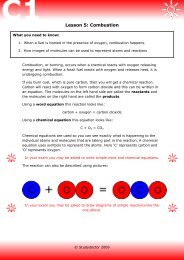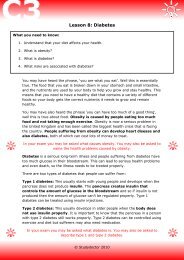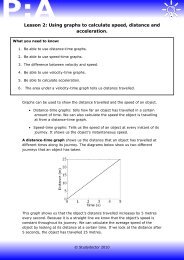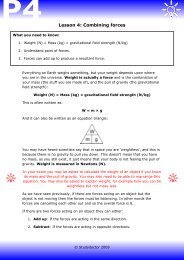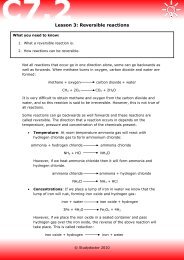Lesson 5: Radioactive decay - Lesson 1
Lesson 5: Radioactive decay - Lesson 1
Lesson 5: Radioactive decay - Lesson 1
You also want an ePaper? Increase the reach of your titles
YUMPU automatically turns print PDFs into web optimized ePapers that Google loves.
<strong>Lesson</strong> 5: <strong>Radioactive</strong> <strong>decay</strong><br />
What you need to know:<br />
1. The structure of an atom.<br />
2. Understand the process of radioactive <strong>decay</strong>.<br />
3. What the three types of radioactive <strong>decay</strong>.<br />
An atom of any element is made of three tiny particles: protons, neutrons and<br />
electrons. The nucleus of the atom contains protons and neutrons and the<br />
number of protons in the nucleus defines what type of element the atom<br />
is. For example, all atoms of Carbon have 6 protons (the atomic number) and all<br />
atoms of nitrogen have 7 protons. Nearly all the mass of the atom is<br />
concentrated in the nucleus.<br />
Orbiting around the nucleus is a shell of electrons, which are usually equal<br />
in number to the number of protons.<br />
Electron<br />
Neutron<br />
Proton<br />
Nucleus<br />
In your exam you may be asked to explain the structure of an atom.<br />
If you look at a periodic table, you may have noticed that the relative atomic<br />
mass (the number in the top left hand corner), is not always a whole number.<br />
The reason for this is that not all atoms of the same element have the same<br />
number of neutrons. Atoms of the same element with different amounts of<br />
neutrons are called isotopes, for example:<br />
1. There are two possible isotopes of oxygen, Oxygen-17 (9 neutrons) and<br />
Oxygen-18 (10 neutrons). These two atoms are isotopes of oxygen and all<br />
must have 8 protons, but each has a different number of neutrons.<br />
© Studydoctor 2009
2. There are two isotopes of carbon, Carbon-11 (5 neutrons) and Carbon-14<br />
(8 neutrons). These two atoms are isotopes of carbon and have 6 protons,<br />
but have different numbers of neutrons.<br />
In your exam you may be asked what an isotope is.<br />
Certain atoms emit ionizing radiation because their nucleuses are unstable and<br />
they can <strong>decay</strong> (change). This is called radioactive <strong>decay</strong> and this is a change<br />
inside the nucleus of the atom.<br />
There are three different types of radioactive <strong>decay</strong><br />
Type of <strong>decay</strong> What is emitted What is happening<br />
Alpha (α) A helium nucleus (2<br />
protons and 2<br />
neutrons). This is called<br />
an alpha particle in<br />
radioactive <strong>decay</strong>.<br />
The nucleus <strong>decay</strong>s, ejecting an<br />
Alpha particle. A new atom is<br />
formed which contains two fewer<br />
protons and neutrons. This new<br />
atom is a different element to the<br />
one you started with.<br />
Beta (β) A high speed electron. The nucleus <strong>decay</strong>s, changing a<br />
neutron into a proton and an<br />
electron. A new atom is formed with<br />
1 less neutron and 1 more proton.<br />
This new atom is a different element<br />
to the one you started with.<br />
Gamma (γ)<br />
Electromagnetic<br />
radiation<br />
Sometimes an atom simply contains<br />
too much energy which it needs to<br />
emit, so it gives off a Gamma ray.<br />
The nucleus remains unchanged.<br />
Alpha <strong>decay</strong><br />
New nucleus<br />
Alpha particle<br />
Unstable nucleus<br />
© Studydoctor 2009
Beta <strong>decay</strong><br />
New nucleus<br />
Beta particle<br />
Unstable nucleus<br />
Gamma <strong>decay</strong><br />
Unstable nucleus<br />
Gamma wave<br />
In your exam you may be asked to identify and explain the three different types<br />
of radioactive <strong>decay</strong>.<br />
When an element occurs in a form where its nucleus is unstable, leading to<br />
radioactive <strong>decay</strong>, it is called a radioactive isotope.<br />
<strong>Radioactive</strong> isotopes are used in hospitals to produce scans and to cure diseases,<br />
but radioactive isotopes are hard to find naturally, as they have <strong>decay</strong>ed.<br />
Therefore, hospitals get supplies of radioactive isotopes from nuclear reactors,<br />
where radioactive isotopes are a by-product of the processes that are happening<br />
in a nuclear reactor.<br />
In your exam you might be asked to describe what a radioactive isotope is. You<br />
may also be asked where hospitals get their supplies of radioactive isotopes.<br />
Recap:<br />
1. An atom has a nucleus which contains protons and neutrons and has a shell of<br />
electrons orbiting around the nucleus.<br />
2. Isotopes are atoms of the same element, which have different numbers of neutrons.<br />
3. <strong>Radioactive</strong> <strong>decay</strong> occurs when unstable atoms <strong>decay</strong>, emitting ionizing radiation.<br />
4. There are three different types of radioactive <strong>decay</strong>, Alpha (α), Beta (β) and Gamma<br />
(γ).<br />
© Studydoctor 2009


